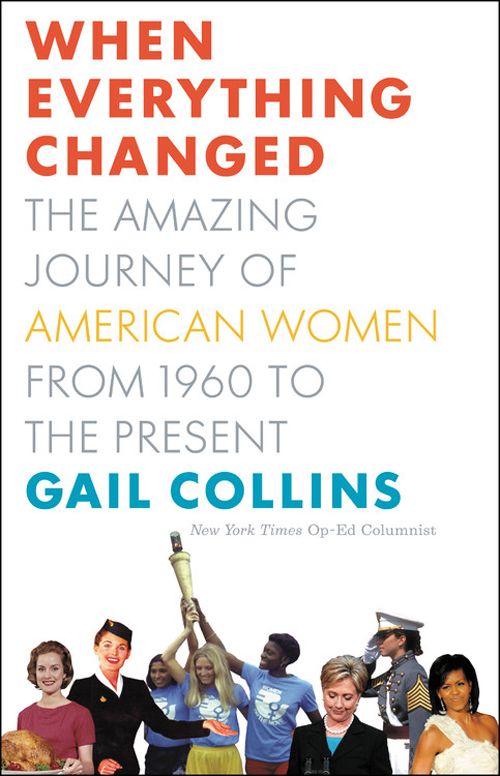Copyright 2009 by Gail Collins
All rights reserved. Except as permitted under the U.S. Copyright Act of 1976, no part of this publication may be reproduced, distributed, or transmitted in any form or by any means, or stored in a database or retrieval system, without the prior written permission of the publisher.
Little, Brown and Company
Hachette Book Group
237 Park Avenue, New York, NY 10017
Visit our website at www.HachetteBookGroup.com
www.twitter.com/littlebrown
First eBook Edition: October 2009
Little, Brown and Company is a division of Hachette Book Group, Inc.
The Little, Brown name and logo are trademarks of Hachette Book Group, Inc.
ISBN: 978-0-316-07166-6
Americas Women: Four Hundred Years of Dolls, Drudges, Helpmates, and Heroines
Scorpion Tongues: Gossip, Celebrity, and American Politics
The Millennium Book (WITH DAN COLLINS)
For Danny

DO YOU APPRECIATE YOURE IN A COURTROOM IN SLACKS?
in the summer of 1960, Lois Rabinowitz, a 28-year-old secretary for an oil-company executive, unwittingly became the feature story of the day in New York City when she went down to traffic court to pay her bosss speeding ticket. Wearing neatly pressed slacks and a blouse, Lois hitched a ride to the courthouse with her husband of two weeks, Irving. In traffic court, Magistrate Edward D. Caiazzo was presiding.
When Lois approached the bench, the magistrate exploded in outrage. Do you appreciate youre in a courtroom in slacks? he demanded, and sent her home to put on more appropriate clothes. Instead, the secretary gave the ticket to her husband, who managed to finish the transaction and pay the $10 finebut not before the magistrate warned the newlywed Irving to start now and clamp down a little or itll be too late. When it was all over, Lois diplomatically told the courthouse reporters that the way the judge thinks about women is very flattering and promised to go home and burn all my slacks.
Since Caiazzo had no known record of tossing out male petitioners who showed up in overalls or sweatshirts, it was pretty clear that the showdown was really about womens place in the world, not the dignity of traffic court. I get excited about this because I hold womanhood on a high plane and it hurts my sensibilities to see women tearing themselves down from this pedestal, the magistrate told reporters. It was a convoluted expression of the classic view of sexual differences: women did not wear the pants in the familyor anywhere else, for that matter. In return, they were allowed to stand on a pedestal.
SHE HAS A HEAD ALMOST TOO SMALL FOR INTELLECT.
The idea that women were the weaker sex, meant to stay at home and tend to the children while the men took care of the outside world, was as old as Western civilization. The colonists who came over on the Mayflower believed that women were morally as well as intellectually and physically inferior, and that they should be married off as early as possible so their husbands could keep them on the straight and narrow. Their ministers enjoyed quoting St. Paul, who had urged the Corinthians to Let your women keep silence in the churches. And if they will learn any thing, let them ask their husbands at home. But it was occasionally difficult to wring the proper degree of deference out of women who had crossed the ocean in small boats, helped carve settlements out of the wilderness, and spent their days alone in isolated farmhouses surrounded by increasingly ticked-off Indians. with some irritation that his sister was not so humble and heavenly as is desired.
The colonial farmwife actually enjoyed considerable status within her family, because she manufactured many of the things her husband and children needed to survive and contributed greatly to the family fortunes. ( remembered her colonial grandmother being busy with candle making, soap making, butter and cheese making, spinning, weaving, dyeing, and of course all the knitting and sewing and dressmaking and tailoring and probably the shoemaking and the millinery for her husband and fourteen children.) But in the nineteenth century, the industrial revolution kicked in, and families began moving to cities. The middle-class housewife stopped spinning thread and making candles, and instead focused her considerable energies on household duties that had been given short shrift in the countryside: nurturing her children like tender little sprouts, cleaning, and cooking effortful dinners. It was all very important, everyone agreed. (And very difficult, considering that making a simple cake before the invention of the eggbeater required three-quarters of an hour of hand beating.) But it did not create wealth, and America was a society that had trouble taking anyone without an economic role seriously.
To raise their stature, women were given the morality franchise. Middle-class society, with womens eager cooperation, placed them on that pedestal. (It was a good metaphorthey got higher status but precious little room to maneuver.) If colonial women were thought to be rather lax and lascivious by nature, in need of correction by their fathers and husbands, Victorian women were elevated as the moral guardians of their families. Men, who used to have that job, could hardly afford to focus on virtue when they had to wring out a living in the dog-eat-dog marketplace. Their wives were going to have to be good enough for both of them. Women were supposed to protect that goodness by staying far away from the outside world of business and politics.. Let us keep our women and children from the contagion as long as possible, wrote Sarah Josepha Hale, the editor of the hugely popular Godeys Ladys Book.
This new feminine portfolio was both empowering and humiliating. A womans impulse toward goodness was seen as instinctual, a God-given gift in a being who was still regarded as none too bright and weak in the face of the terrors of the outside world.. The household altar is her place of worship and service, said Dr. Charles Meigs in a famous lecture to nineteenth-century male gynecology students. She has a head almost too small for intellect and just big enough for love.
The central point in the Western vision of sexual differences was that a womans place was in the home, leaving men to run everything that went on outside the front door. Men provided and protected; women served and deferred. It was an ancient and extremely durable theory but riddled with holes. For one thing, it ignored the problem of what happened to these dependent creatures if their husbands failed to live up to their end of the bargain by dying, taking to drink, or abandoning the family. (, ex-slaves who wanted to take care of their families full-time were hounded into domestic service or fieldwork amid white denunciation of black female loaferism. Most rural farmwives had to labor in the fields with their husbands rather than presiding over the hearth, and many urban women, black and white, had to earn wages to help feed their families.
But for the middle class, the rule about womens place endured. Remarkable women might, on occasion, merge marriage, motherhood, and work, or carve out a career for themselves in traditionally male occupations. But women who worked as doctors, architects, and politicians were always the rare exceptions, never the precursors of change. They were depicted in the media as strange mutationsfemale physician or lawyer and grandmotherwhose achievements could never be mentioned except in the context of their femaleness. , a member of the Society of Plastics Engineers, wrote an article for the











